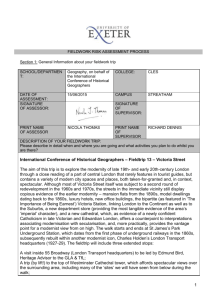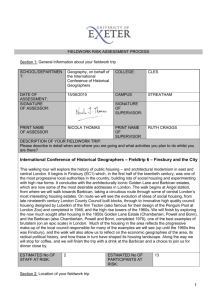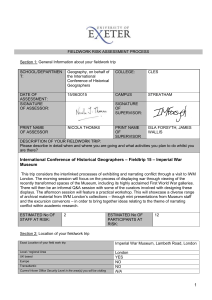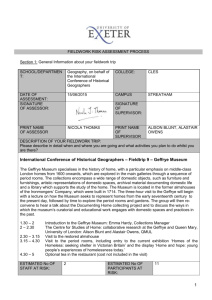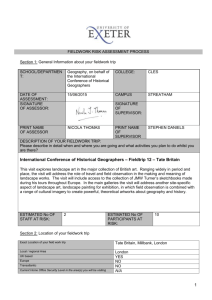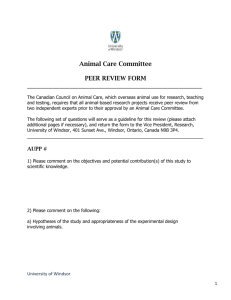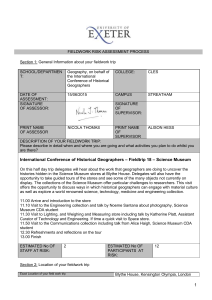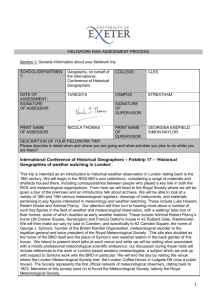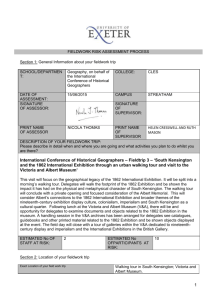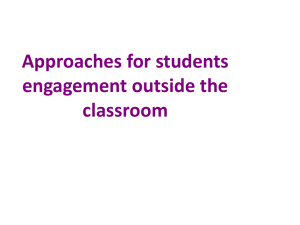Windsor - International Conference of Historical Geographers 2015
advertisement
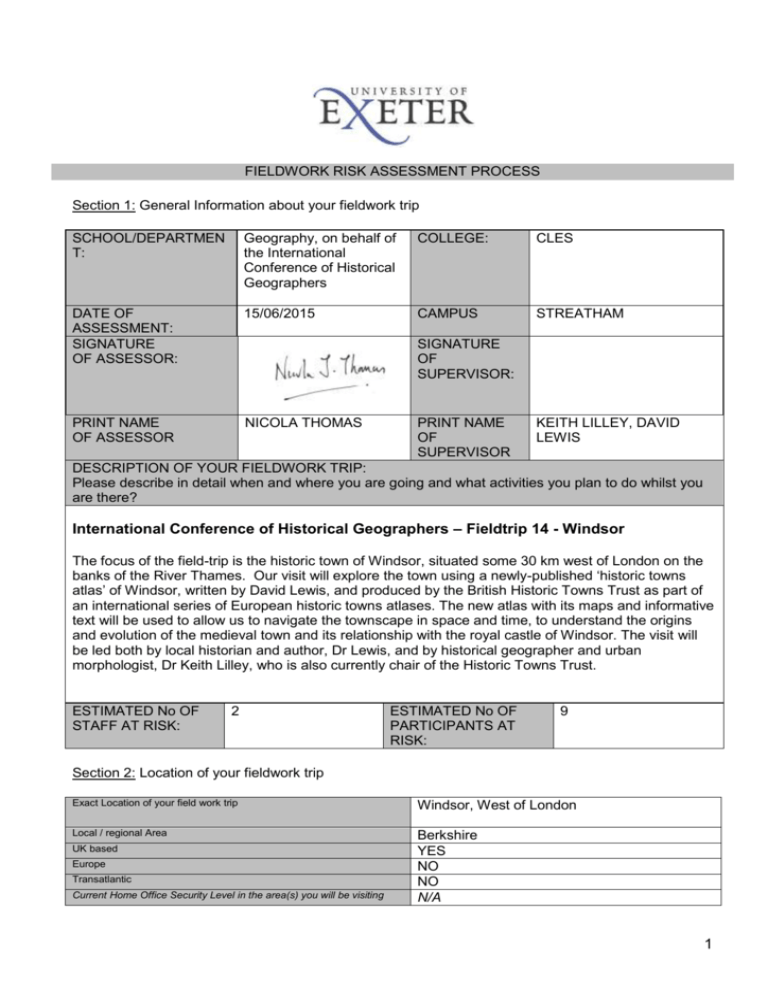
FIELDWORK RISK ASSESSMENT PROCESS Section 1: General Information about your fieldwork trip SCHOOL/DEPARTMEN T: Geography, on behalf of the International Conference of Historical Geographers COLLEGE: CLES DATE OF ASSESSMENT: SIGNATURE OF ASSESSOR: 15/06/2015 CAMPUS STREATHAM PRINT NAME OF ASSESSOR NICOLA THOMAS SIGNATURE OF SUPERVISOR: PRINT NAME OF SUPERVISOR KEITH LILLEY, DAVID LEWIS DESCRIPTION OF YOUR FIELDWORK TRIP: Please describe in detail when and where you are going and what activities you plan to do whilst you are there? International Conference of Historical Geographers – Fieldtrip 14 - Windsor The focus of the field-trip is the historic town of Windsor, situated some 30 km west of London on the banks of the River Thames. Our visit will explore the town using a newly-published ‘historic towns atlas’ of Windsor, written by David Lewis, and produced by the British Historic Towns Trust as part of an international series of European historic towns atlases. The new atlas with its maps and informative text will be used to allow us to navigate the townscape in space and time, to understand the origins and evolution of the medieval town and its relationship with the royal castle of Windsor. The visit will be led both by local historian and author, Dr Lewis, and by historical geographer and urban morphologist, Dr Keith Lilley, who is also currently chair of the Historic Towns Trust. ESTIMATED No OF STAFF AT RISK: 2 ESTIMATED No OF PARTICIPANTS AT RISK: 9 Section 2: Location of your fieldwork trip Exact Location of your field work trip Windsor, West of London Local / regional Area Berkshire YES NO NO N/A UK based Europe Transatlantic Current Home Office Security Level in the area(s) you will be visiting 1 Section 3: the Hazards involved in the work you are planning Highlight the relevant hazards in the list below Climate: Based in UK urban areas with potential exposure to sun, wind and rain. Temperatures could fall between 13 and 28 degrees depending on weather conditions. Terrain/Location: Fieldtrip will be in urban location with sustained traffic on nearby streets. There may be uneven pavements and steps. Participants will visit public buildings. Biological: NONE Chemical: NONE Mechanical: NONE Electrical: NONE Human Activity: Participants will be in together in a group. This can mean that individuals cease paying attention to their own safety. Recreation: NONE Work Procedures: Participants will be travelling as a group. We will be in an urban location so a possible hazard could be assault or theft. People may have less awareness of their position and step into the road or slip off pavements. There is a risk of injury in relation to trips and falls and accidents involving cars. Work Abroad: n/a Other Stressors: General: Pre-existing conditions, Food intolerance/allergy Behaviour: Participants are adults from different countries. There may be unanticipated differences or misunderstandings. Legal problems: NA Security: NA 2 Section 4 – Your assessment of the risks (Risk Assessment) 1 Hazard number What is the hazard (e.g. low temperature, falling rocks) 1. (C) Consequenc e (1-5) X 3 X 5 X (L) Likelihood (1-5) = (RS) Risk Score (1-25) Action to be taken to control the risk (please list all actions you will be taking) Residual Risk (the remaining risk once your controls are put in place) C X L = RS 2 = 5 1 x 1 = 1 1 = 5 Participants asked to carry water and weather protection clothing (including sunscreen, hats and wet weather gear). Field leaders to carry sunscreen Field leaders to remind participants to carry water and apply sun cream at the start of the trip if they are outside for significant time. Participants warned about the risk; participants reminded to use pavements and pedestrian crossing points. 1 X 1 = 1 1 X 1 = 1 Climate: sun rain, wind exposure 2. Terrain/Location: Fieldtrip will be in urban location with sustained traffic on nearby streets. There maybe uneven pavements and steps. Field leader to identify emergency exit codes in any buildings visited and to alter participants to these. Participants will visit public buildings. 3. 5 Human activity: Participants will be in together in a group. This can mean that individuals cease paying attention to their own safety. Specific aspects requiring attention include disembarking X 1 = 5 Participants alerted to risk. Field leaders to alert participants of potential risks and direct them clearly to safe routes. 3 from transport and crossing roads. 4. 5. 6. Work Procedures: lack of awareness, slipping in an unfamiliar urban environment. Lacking attention to traffic. General: Pre-existing conditions, Food intolerance/allergy, Foot problems, Lack of fitness, exhaustion. Behaviour: Participants are adults from different countries. There may be unanticipated differences or misunderstandings. 5 X 1 = 5 Participants warned about the risk; participants reminded to use pavements and pedestrian crossing points; 1 X 1 = 1 1 X 1 = 1 1 X 1 = 1 1 X 1 = 1 Participants asked to disclose pre-existing medical /dietary conditions which may cause risk . Participants have been asked to indicate dietary requirements so allergic reactions are unlikely to be a problem. Field leaders will be reminded to call emergency services should any need arise, This is unlikely to cause difficulties as participants share a common bond. Field leader to be aware of group dynamics and to diffuse any tensions. 1 X 1 = 1 4 5
